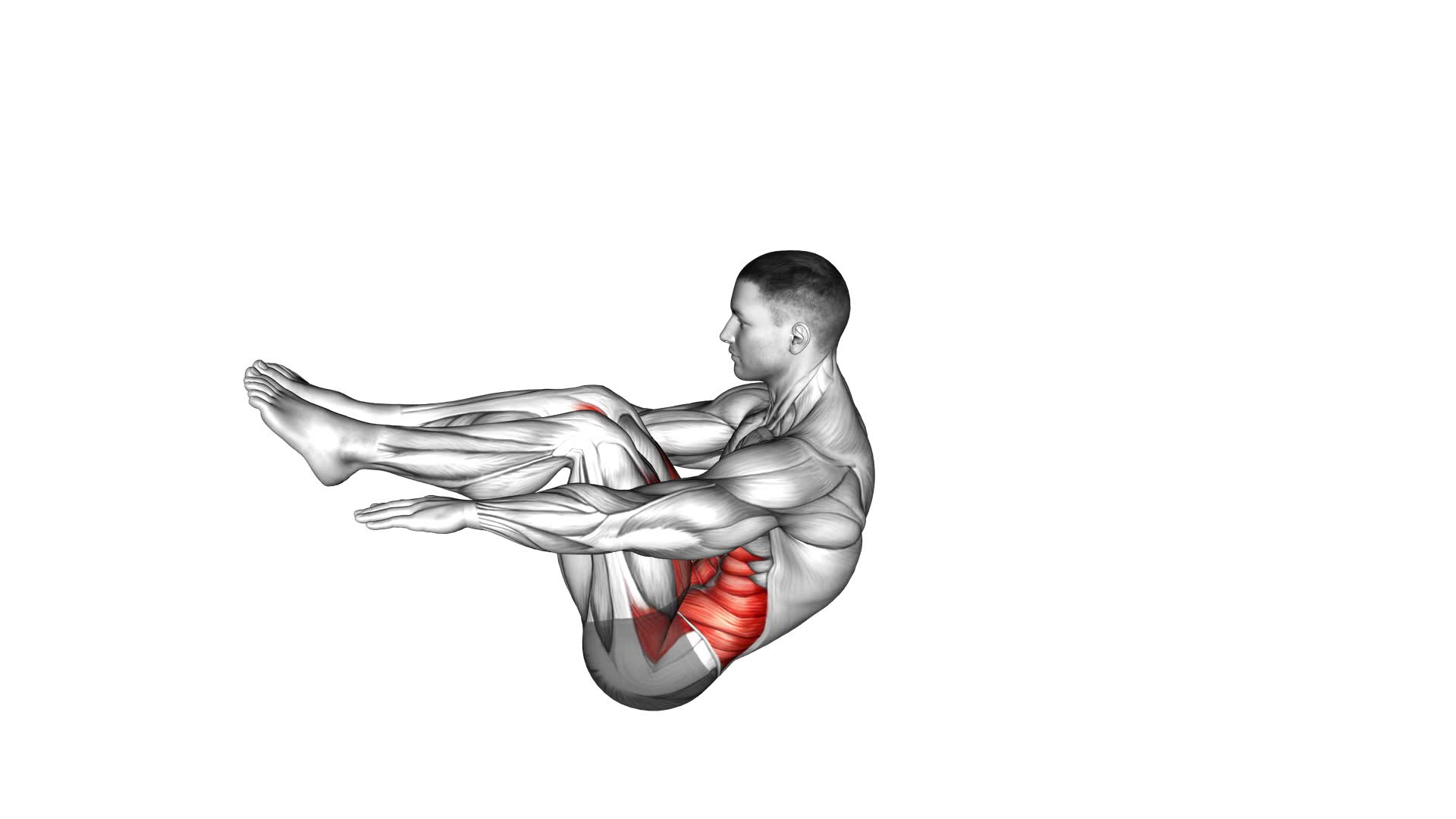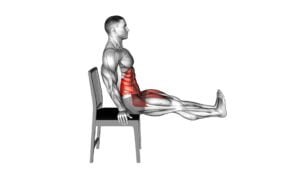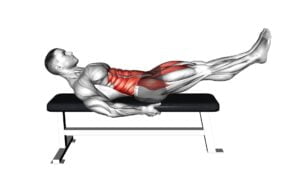V-up Hold (male) – Video Exercise Guide & Tips

Are you looking for a challenging exercise that targets your core muscles? Look no further than the V-up hold!
Watch This Exercise Video
In this video exercise guide, we'll show you the proper form and technique to maximize your results. Discover the benefits of this exercise and learn how to modify it for beginners.
Avoid common mistakes and explore advanced variations to take your workout to the next level.
Get ready to strengthen your core with the V-up hold!
Key Takeaways
- Proper form and technique for V-up Hold includes using a firm and stable surface for support, engaging the abdominal muscles, lifting legs and torso simultaneously to form a 'V' shape, and maintaining control and stability throughout the exercise.
- V-up Hold increases core strength, targets abs, obliques, and hip flexors, enhances stability, posture, coordination, and balance, improves athletic performance, and sculpts and defines the abdominal area.
- Beginners can start with a supported version by lying on their back with bent legs and hands under their lower back, progress to lifting their feet off the ground and bringing their knees towards their chest, and eventually work up to the full V-up Hold by extending their legs and reaching their arms towards their toes.
- Common mistakes to avoid during V-up Hold include relying on momentum instead of engaging core muscles, arching the back instead of keeping it flat on the ground, not breathing properly, neglecting progression, and not focusing on form and control to maximize effectiveness.
Proper Form and Technique
To maintain proper form and technique during the V-up Hold exercise, ensure that you use a firm and stable surface to support your body. This is essential to prevent any wobbling or shifting that may compromise your balance and overall performance.
Many people have common misconceptions about this exercise, thinking that simply raising your legs and torso off the ground is enough. However, it's important to engage the key muscles targeted in this exercise – primarily the abdominal muscles, including the rectus abdominis and the obliques.
By contracting these muscles, you can achieve a more effective and efficient V-up Hold. To do this, focus on lifting your legs and torso simultaneously, bringing them together as close as possible while maintaining control and stability. Imagine forming a 'V' shape with your body, with your hands reaching towards your toes.
Remember to keep your core tight throughout the exercise and avoid straining your neck or lower back. By following these guidelines, you can maximize the benefits of the V-up Hold and achieve optimal results.
Benefits of the V-up Hold
Experience increased core strength and improved abdominal muscle definition by incorporating the V-up Hold into your workout routine. This challenging exercise targets your abs, obliques, and hip flexors, helping to strengthen and tone these muscles.
By engaging your core throughout the movement, you'll not only build a solid foundation for other exercises but also improve your overall stability and posture. The V-up Hold forces you to maintain a stable position, which activates multiple muscle groups simultaneously, leading to better coordination and balance.
Moreover, this exercise can help to improve your athletic performance in sports that require explosive movements or quick changes in direction. By regularly performing the V-up Hold, you'll notice an increase in your core strength and stability, as well as a more defined and sculpted abdominal area.
So, if you're looking to improve your core strength and define your abs, incorporating the V-up Hold into your workout routine is a great choice.
Now, let's move on to how to modify the V-up Hold for beginners.
How to Modify the V-up Hold for Beginners
To modify the V-up Hold for beginners, start by performing a supported version of the exercise.
Lie on your back with your legs bent and your feet flat on the ground. Place your hands underneath your lower back for support.
Engage your core and lift your feet off the ground, bringing your knees towards your chest. Hold this position for a few seconds, focusing on maintaining stability and balance.
As you build strength and confidence, you can progress to the full V-up Hold.
Extend your legs fully, reaching your arms towards your toes as you lift your upper body off the ground. Keep your core engaged and your back straight throughout the movement.
Remember to breathe steadily and avoid straining your neck or shoulders.
As with any exercise, it's important to listen to your body and only progress to more challenging variations when you feel ready.
With consistent practice, you'll be able to perform the V-up Hold with proper form and control.
Common Mistakes to Avoid
Avoid these common mistakes when performing the V-up Hold:
- Relying on momentum: One of the most common mistakes is using momentum to lift your legs instead of engaging your core muscles. This not only reduces the effectiveness of the exercise but also increases the risk of injury. Focus on using your abdominal muscles to lift your legs and maintain control throughout the movement.
- Arching your back: Another mistake is arching your back instead of keeping it flat on the ground. Arching your back puts unnecessary strain on your lower back and takes the focus away from your core. Keep your back flat against the ground throughout the exercise to ensure proper form and maximum engagement of your abdominal muscles.
- Not breathing properly: It's important to breathe in a controlled manner during the V-up Hold. Many people tend to hold their breath or breathe shallowly, which can lead to fatigue and decreased performance. Remember to inhale as you lower your legs and exhale as you lift them, maintaining a steady breathing pattern throughout.
- Neglecting progression: To continue challenging your core and make progress, it's important to gradually increase the difficulty of the V-up Hold. This can be done by adding weights, extending the duration, or incorporating variations such as the bicycle V-up. Progression is key to building strength and achieving your fitness goals.
Advanced Variations of the V-up Hold
Try incorporating these challenging variations of the V-up Hold to take your core workout to the next level. By adding advanced modifications and techniques to your routine, you can intensify the exercise and target your abdominal muscles even more effectively.
One advanced modification you can try is the Weighted V-up Hold. Instead of performing the exercise without any additional weight, hold a dumbbell or a medicine ball in your hands as you lift your legs and torso off the ground. The added resistance will increase the difficulty and engage your core muscles even further.
Another advanced technique is the Alternating V-up Hold. Instead of keeping both legs extended throughout the exercise, alternate lifting one leg at a time while the other remains hovering above the ground. This modification challenges your stability and coordination, forcing your core muscles to work harder to maintain balance.
Finally, you can try the Side V-up Hold to target your obliques. Lie on your side with your legs extended and lift your torso and legs off the ground, forming a V-shape. This variation focuses on the muscles on the sides of your abdomen, helping you develop a well-rounded core.
Incorporating these advanced variations of the V-up Hold into your workout routine will challenge your core muscles in new ways and help you achieve greater strength and definition. Remember to start with proper form and gradually increase the difficulty as you become more comfortable with each modification.
Frequently Asked Questions
How Many Calories Can You Burn by Doing the V-Up Hold Exercise?
You can burn a significant amount of calories by doing the v-up hold exercise. This exercise is highly effective for targeting your core muscles and can help you build strength and stability.
The v-up hold requires you to engage your abs, lower back, and hip flexors, resulting in a higher calorie burn compared to other exercises.
Incorporating this exercise into your workout routine can contribute to overall calorie expenditure and help you achieve your fitness goals.
Can the V-Up Hold Help in Reducing Belly Fat?
The V-up hold is a fantastic exercise for reducing belly fat and improving overall core strength. It targets the abdominal muscles and helps to tone and tighten your midsection.
The V-up hold can be modified for beginners by bending the knees and bringing them towards the chest instead of extending the legs straight out. This modification allows beginners to build strength and gradually progress to the full V-up hold.
Incorporating this exercise into your routine will bring you closer to achieving your fitness goals.
Is It Safe to Perform the V-Up Hold Exercise if You Have Lower Back Pain?
Performing the V-up Hold exercise when you have lower back pain may not be safe. Lower back pain can be aggravated by the V-up Hold movement, putting added stress on your back.
It's important to listen to your body and avoid any exercises that cause discomfort or pain. If you still want to work on your core without straining your lower back, there are modifications available for the V-up Hold that can help alleviate the pressure on your back.
How Often Should the V-Up Hold Exercise Be Done for Optimal Results?
For optimal results, how often should you do the v-up hold exercise?
The frequency of the v-up hold exercise depends on your fitness level and goals. To enhance core strength, it's recommended to perform this exercise 2-3 times per week.
The v-up hold targets the abdominal muscles, improving stability and balance. Regularly incorporating this exercise into your routine can lead to a stronger core and improved overall fitness.
Are There Any Alternative Exercises That Can Be Done Instead of the V-Up Hold for Targeting the Same Muscles?
Looking for alternative exercises to target the same muscles as the V-up Hold? No problem! There are plenty of options. Modifying the V-up Hold with bent knees or using a stability ball can make it easier for beginners.
To target your core muscles, try exercises like planks, Russian twists, or bicycle crunches. These exercises not only strengthen your core but also improve overall strength.
Conclusion
In conclusion, the V-up hold is a challenging core exercise that can help improve strength and stability. By maintaining proper form and technique, individuals can reap the benefits of this exercise, such as enhanced abdominal strength and improved posture.
Beginners can modify the V-up hold by starting with bent knees or performing the exercise on a stability ball. It's important to avoid common mistakes, such as lifting the shoulders off the ground or using momentum to complete the movement.
Advanced variations of the V-up hold can further intensify the workout for those seeking a greater challenge.

Author
Years ago, the spark of my life’s passion ignited in my mind the moment I stepped into the local gym for the first time. The inaugural bead of perspiration, the initial endeavor, the very first surge of endorphins, and a sense of pride that washed over me post-workout marked the beginning of my deep-seated interest in strength sports, fitness, and sports nutrition. This very curiosity blossomed rapidly into a profound fascination, propelling me to earn a Master’s degree in Physical Education from the Academy of Physical Education in Krakow, followed by a Sports Manager diploma from the Jagiellonian University. My journey of growth led me to gain more specialized qualifications, such as being a certified personal trainer with a focus on sports dietetics, a lifeguard, and an instructor for wellness and corrective gymnastics. Theoretical knowledge paired seamlessly with practical experience, reinforcing my belief that the transformation of individuals under my guidance was also a reflection of my personal growth. This belief holds true even today. Each day, I strive to push the boundaries and explore new realms. These realms gently elevate me to greater heights. The unique combination of passion for my field and the continuous quest for growth fuels my drive to break new ground.



